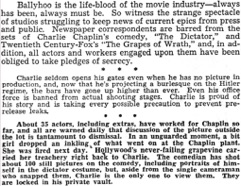The Great Dictator 1939 1941 next previous
The Great Dictator Clippings 63/369
Daily Variety, New York, December 31, 1939.
Film Star at Fairbanks Funeral
THIS A. P. WIREPHOTO IS FROM GLENDALE, CALIF.
Among pioneers of the motion picture world who had
known Douglas Fairbanks for years and gathered for his
funeral was Charlie Chaplin, one of the pallbearers.
He is seen here arriving at Forest Lawn Memorial park
for the final rites.
(...) AP Photo, Spokesman-Review, Spokane,
Washington, Dec. 17, 1939.
AP, Associated Press.
& Charlie so completely broken up about Douglas
Fairbanks, he‘s dining quietly at the studio every night. Jack
and Venita Oakie were his guests last night.
(...) SNAPSHOTS OF HOLLYWOOD collected at random,
By Louella O. Parsons, Motion Picture Editor
Int‘l News Service, San Francisco Examiner, San Francisco,
California, Dec. 16, 1939
& Ballyhoo is the life-blood of the movie-industry – always
has been, always must be. So witness the strange
spectacle of studios struggling to keep news of current epics
from press and public. Newspaper correspondents
are barred from the sets of Charlie Chaplin‘s comedy, „The
Dictator,“ and Twentieth Century-Fox‘s „The Grapes
of Wrath,“ and, in addition, all actors and workers engaged
upon them have been obliged to take pledges
of secrecy.
* * *
Charlie seldom opens his gates even when ha has no
picture in production, and, now that he‘s projecting
a burlesque on the Hitler regime, the bars have gone up
higher than ever. Even his office force is banned
from actual shooting stages. Charlie is proud of his story
and is taking every possible precaution to prevent
prerelease leaks.
* * *
About 35 actors, including extras, have worked for
Chaplin so far, and all are warned daily that
discussion of the picture outside the lot is tantamount
to dismissal. In an unguarded moment, a bit girl
dropped an inkling of what went on at the Chaplin plant.
She was fired next day. Hollywood‘s never-failing
grapevine carried her treachery right back to Charlie.
The comedian has shot about 100 still pictures
on the comedy, including portraits of himself in the
dictator costume, but, aside from the single
cameraman who snapped them, Charlie is the only one
to view them. They are locked in his private vault.
(...) HOLLYWOOD Behind the Camera By Harold HEFFERNAN,
Boston Globe, Boston, Massachusetts, Dec. 29, 1939.
Lead. Studios struggle to keep films secret . . . Discussion
sometimes carries penalty of dismissal on Chaplin set
Photo. CHARLES CHAPLIN
& Vince Barnett, the talk of Hollywood several years ago
with his famous „ribbing“ antics, has been signed for the role
of a screwball inventor in Chaplin‘s „The Dictator.“
(...) Louella O. Parsons, Courier-Post, Camden, New Jersey,
Jan. 1, 1940
„Displayed an unusually keen sense of humor“
Editorial content. „The Great Dictator
Chaplin makes no bones about his utter contempt
for dictators like Hitler and Mussolini in his production of The
Great Dictator. He takes time out to make fun about it,
but the preachment is strong, notably in the six-minute speech
at the finish.
By VARIETY STAFF
Chaplin speaks throughout the film, but whenever
convenient depends as much as he can on pantomime. His
panto has always talked plenty.
Chaplin plays a dual role, that of a meek little Jewish
barber in Tomania and the great little dictator of that
country, billed as Hynkel. It‘s when he is playing the dictator
that the comedian‘s voice raises the value of the
comedy content of the picture to great heights. He does
various bits as a Hitler spouting at the mouth in which
he engages in a lot of double talk in what amounts amounts
to a pig-Latin version of the German tongue, with
grunts thrown in here and there, plus a classical ,Democracy
shtoonk‘. On various occasions as Hitler he also
speaks English, in these instances he talks with force,
as contrasted by the mousey, half-scared way
he speaks as the poor barber.
Somewhat of a shock is the complete transformation
of the barber when he delivers the speech at the finish, a fiery
and impassioned plea for freedom and democracy.
It is a peculiar and somewhat disappointing climax with the
picture ending on a serious rather than a comical note.
The vast majority of the action is built around Hynkel and
the Jewish barber. Not so much is devoted to the
dictator who is Napaloni (Mussolini). Jack Oakie plays the
satirized Duce to the hilt and every minute with him
is socko.
In making up the billing, Chaplin has displayed an unusually
keen sense of humor. While Hynkel is the dictator
of Tomania, Napaloni is the ruler of Bacteria. Tomasia
higher-ups include Garbitsch (Goebels) and Herring
(Goering). These are played effectively by Henry Daniell and
Billy Gilbert.“
Redaktioneller Inhalt
The Great Dictator 1939 1941 next previous





